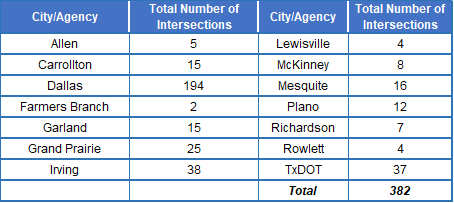Wrong Way Driving
Combating Wrong Way Driving Throughout the Region
Crashes caused by wrong-way driving, while uncommon, are especially dangerous and often fatal. Due to the severity of these incidents, NCTCOG and our regional partners have initiated efforts to prevent these incidents through the Wrong-Way Driving (WWD) Mitigation Pilot Program. This program is coordinated with the TxDOT Dallas and Fort Worth Districts in order to implement intersection, roadway, and technological improvements that reduce the frequency of wrong-way driving crashes. Past and current efforts have been separated into two phases.
Phase I — Dallas County
In 2014, NCTCOG, TxDOT, and nine cities in Dallas County initiated Phase I of the WWD Pilot Project. The goal of Phase I was to prevent wrong-way driving along regional corridors by improving intersections, signage, and/or other countermeasures. The project initially focused on 350 diamond interchanges, which connect streets and highways throughout Dallas County. Phase I improvements included eliminating conflicting lane assignment signs and pavement markings; placing straight arrow markings in extended bays; modifying signage message, size, and location; and making minor traffic signal enhancements such as installing light-emitting diode bulbs and utilizing vertical green arrows instead of the traditional green balls.
Since the initiation of Phase I, eight cities (Carrollton, Farmers Branch, Garland, Grand Prairie, Irving, Mesquite, Richardson and Rowlett) have completed construction of these countermeasures. The project has also been expanded into Collin and Denton Counties where improvements have entered either the design or construction phase in Allen, McKinney, Plano, Carrollton (Denton County), and Lewisville. Work continues in Dallas County, where intersections along US 75 entered the design phase in early 2018.
Phase I - Cities Participating in the
Wrong-Way Driving Pilot Project in Collin, Dallas, and Denton Counties

Phase II — Tarrant County
Phase II of the WWD project was initiated in 2015 and focused on 54.2 miles of seven priority freeway corridors in Tarrant County. Addressing WWD incidents on limited-access facilities, Phase II improvements include the addition of wrong-way pavement markings in the travel lanes; enhanced signage with active detection units; optimized sign placement; and use of technology for wrong-way driving incident notifications.
